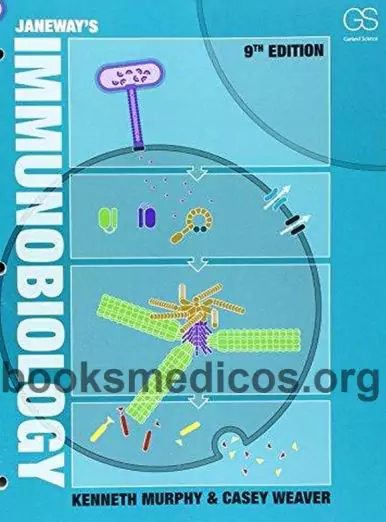‘Immunobiology Latest Edition’ PDF Quick download link is given at the bottom of this article. You can see the PDF demo, size of the PDF, page numbers, and direct download Free PDF of ‘Janeway’s Immunobiology Loose Leaf’ using the download button.
Janeway’s Immunobiology 9th Book PDF Free Download

Immunology Janeway
Immunology is the study of the body’s defense against infection.
We are continually exposed to microorganisms, many of which cause disease, and yet become ill only rarely.
How does the body defend itself? When infection does occur, how does the body eliminate the invader and cure itself?
And why do we develop long-lasting immunity to many infectious diseases encountered once and overcome? These are the questions addressed by immunology, which we study to understand our body’s defenses against infection at the cellular and molecular levels.
The beginning of immunology as a science is usually attributed to Edward Jenner for his work in the late 18th century (Fig. 1.1).
The notion of immunity— that surviving a disease confers greater protection against it later—was known since ancient Greece.
Variolation—the inhalation or transfer into superficial skin wounds of material from smallpox pustules—had been practiced since at least the 1400s in the Middle East and China as a form of protection against that disease and was known to Jenner.
Jenner had observed that the relatively mild disease of cowpox, or vaccinia, seemed to confer protection against the often fatal disease of smallpox, and in 1796, he demonstrated that inoculation with cowpox protected the recipient against smallpox.
His scientific proof relied on the deliberate exposure of the inoculated individual to infectious smallpox material two months after inoculation.
This scientific test was his original contribution. Jenner called the procedure vaccination.
This term is still used to describe the inoculation of healthy individuals with weakened or attenuated strains of disease-causing agents in order to provide protection from disease.
Although Jenner’s bold experiment was successful, it took almost two centuries for smallpox vaccination to become universal.
This advance enabled the World Health Organization to announce in 1979 that smallpox had been eradicated (Fig. 1.2), arguably the greatest triumph of modern medicine.
Jenner’s strategy of vaccination was extended in the late 19th century by the discoveries of many great microbiologists.
Robert Koch proved that infectious diseases are caused by specific microorganisms.
In the 1880s, Louis Pasteur devised a vaccine against cholera in chickens and developed a rabies vaccine that proved to be a spectacular success upon its first trial in a boy bitten by a rabid dog.
These practical triumphs led to a search for vaccination’s mechanism of protection and to the development of the science of immunology.
In the early 1890s, Emil von Behring and Shibasaburo Kitasato discovered that the serum of animals immune to diphtheria or tetanus contained a specific ‘antitoxic activity’ that could confer short-lived protection against the effects of diphtheria or tetanus toxins in people.
This activity was later determined to be due to the proteins we now call antibodies, which bind specifically to the toxins and neutralize their activity.
That these antibodies might have a crucial role in immunity was reinforced by Jules Bordet’s discovery in 1899 of complement, a component of serum that acts in conjunction with antibodies to destroy pathogenic bacteria.
A specific response against infection by potential pathogens, such as the of antibodies against a particular pathogen, is known as adaptive immunity because it develops during the lifetime of an individual as an adaptation to infection with that pathogen.
Adaptive immunity is distinguished from innate immunity, which was already known at the time von Behring was developing serum therapy for diphtheria chiefly through the work of the great Russian immunologist Elie Metchnikoff, who discovered that many microorganisms could be engulfed and digested by phagocytic cells, which thus provide defenses against infection that are nonspecific.
Whereas these cells— which Metchnikoff called ‘macrophages’—are always present and ready to act, adaptive immunity requires time to develop but is highly specific.
It was soon clear that specific antibodies could be induced against a vast range of substances, called antigens because they could stimulate antibody generation.
Paul Ehrlich advanced the development of an antiserum as a treatment for diphtheria and developed methods to standardize therapeutic serums.
Today the term antigen refers to any substance recognized by the adaptive immune system.
Typically antigens are common proteins, glycoproteins, and polysaccharides of pathogens, but they can include a much wider range of chemical structures, for example, metals such as nickel, drugs such as penicillin, and organic chemicals such as the urushiol (a mix of pentadecylcatechols) in the leaves of poison ivy.
Metchnikoff and Ehrlich shared the 1908 Nobel Prize for their respective work on immunity.
This chapter introduces the principles of innate and adaptive immunity, the cells of the immune system, the tissues in which they develop, and the tissues through which they circulate.
We then outline the specialized functions of the different types of cells by which they eliminate the infection.
| Author | – |
| Language | English |
| No. of Pages | 927 |
| PDF Size | 50 MB |
| Category | Subject |
| Source/Credits | files.wordpress.com |
Janeway’s Immunobiology Book PDF Free Download
